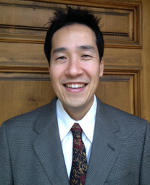 Patrick Takahashi, MD, Chief of the Gastroenterology Section at St. Vincent Medical Center, discusses his role in spearheading the electronic health record implementation process at the medical center.
Patrick Takahashi, MD, Chief of the Gastroenterology Section at St. Vincent Medical Center, discusses his role in spearheading the electronic health record implementation process at the medical center. Q: Where does the medical center currently stand in the EHR implementation process?
Dr. Patrick Takahashi: We began the process of implementation over the summer. It has been quite the learning curve for many of the physicians. Implementation has been completed and we are now fine-tuning the process and working towards meaningful use.
Q: What have been a few of the biggest challenges you encountered during the process?
PT: It has been extremely challenging. Some of our physicians were well-versed in EHR due to working with one in their office-based practices. About 50 to 60 percent of our physicians had no familiarity with EHR at all. It is an ongoing process. EHR represents a dramatic change in work flow. You are trying to mimic what was once done on paper, but as simple as something may sound on paper, the translation to EHR is not always smooth. Physicians need to learn how to do everything line by line: click on an order, go through the acknowledgement process, read any warnings, etc. While many of these steps provide a safety measure, it is not welcome in every instance.
Q: How has EHR implementation impacted physician's workload?
PT: EHR approximately adds about 20 minutes of work a day for a technology-savvy physician, which is not terrible. For those physicians who aren't familiar with EHR, it could add close to an hour of extra rounding time during the initial acclimation process.
Q: What benefits do you expect to see from EHR implementation?
PT: We are looking forward, and there will be improvement. The actual time needed to use the EHR will decrease as physicians become more comfortable with usage. Already, physicians have all of the necessary information about patients at their fingertips. Physicians can access this information from multiple locations, including the hospital, home, office, and on a mobile device. Tests can be ordered anytime and patient charts are always within easy reach. Physicians can ensure that tests won't be duplicated and they no longer have to wait for a paper chart to review old records, which could sometimes take upwards of an hour after request.
Overall, the major benefits revolve around safety issues. EHR helps physicians avoid medication errors. All medications are documented digitally and will be screened for any potential medication interactions or side effects.
EHR also supports collaborative care. Physicians are able to interact with one another through the system. For instance, laboratory and radiological tests colleagues have ordered are readily displayed and information often lost in the shuffle of paper charts is easily visible.
Q: How did you weigh the difficulties against the benefits?
PT: The main thing we have to consider is that EHR is now a part of the fabric of daily practice. The shift to a value-based system and PPACA mandates ensure that physicians need to be intent on reporting certain core measures for meaningful use. We need EHR. Gastroenterologists, and all physicians, will be able to aggregate data from the EHR. From a time standpoint, initial implementation is going to slow physicians down, but this will be offset by the data they will be able to accrue and report to governmental and insurance agencies. It is inevitable that billing and reimbursement will become dependent upon measures that are reported, with the EHR leading the way.
For example, in a gastroenterology practice physicians may be required to report the number of Hepatitis C patients that have been vaccinated with a Hepatitis A vaccine. With EHR, physicians will be able to easily populate a list of patients with quick submission in a digital format, but in a paper world you would never be able to get this done without going through a multitude of charts individually.
Q: How did you work with individual physicians to help them through the implementation process?
PT: The run of the mill approach involves a series of group meetings, with vetting of orders specific to certain specialties. Ultimately, individual contact with physicians has been the key. We have learned more about the EHR after going live with the product. It has really been a grass roots campaign. We had to talk to physicians both in person and on the phone, listen to their issues, assign potential trainers, go to physical sites in the hospital to help and really take into account the information that was gathered to make changes on the fly. We would then help create and streamline individualized order sets to help physicians.
I would preach patience to the physicians in the initial stages of EHR implementation and going forward. EHR is here to stay, so it behooves people to try to embrace the process instead of having acrimony. It is important to encourage physicians to get actively involved in the process, helping to make changes which will fit their workflows better. There can be a certain amount of resentment, but an active role will help physicians to work through and understand the system. This approach has led to a very successful launch, and allows the system to work more for the physician.
More Articles on Gastroenterology:
6 Statistics on GI/Endoscopy Revenue Per Case in Surgery Centers by Number of ORs
5 Opportunities for GI Centers to Overcome Healthcare Reform Challenges
GERD Awareness Week: 4 Things to Know From Dr. Gilbert Simoni


